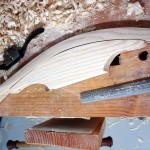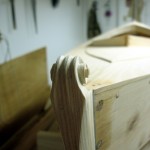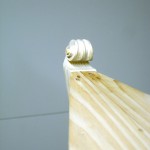These were too easy. So, I had to make them harder.
The false stems are white ash, hard enough to be the boat’s shock absorbers. They are only about an inch thick, in either dimension, but are curved in almost all directions. Rough patterns made of thin plywood held up against the ends of the boat (one at each end) provided the initial cutting lines.
I thought they would be difficult to fit but was very pleasantly surprised. The trick is chalk. Coat the fixed surface with a heavy layer of chalk. Place the false stem piece against the chalked surface and wiggle back and forth. The transferred chalk marks the high spots. There might be only a few at the start. Remove them. Repeat until the fit is so good that the whole piece is covered with chalk. It goes a lot faster than I expected.
 Beveling comes after fitting. So, how do we hold the clumsy pieces? Some scrap stock screwed to the inside of the curve offers a lot of surface for the leg vice to hold. Beveling is also pretty quick work with a sharp spokeshave (Stanley #51, circa 1920) and a cabinet rasp.
Beveling comes after fitting. So, how do we hold the clumsy pieces? Some scrap stock screwed to the inside of the curve offers a lot of surface for the leg vice to hold. Beveling is also pretty quick work with a sharp spokeshave (Stanley #51, circa 1920) and a cabinet rasp.
So far, so easy. Too easy. Can’t have that. Let’s make it a bit more difficult.
Harry Bryan called these boats “Fiddleheads” for some reason I don’t know. Why stick with the usual ogee curve found atop many stems? How about decorating the tops of the false stems with fiddleheads? Hmmm. Never carved one of those. Actually, I’ve never carved much of anything. Off to the world wide library to find some examples. …

 Some basic carving chisels and some practice time on a scrap of ash led to the following conclusion. Don’t let anyone tell you that ash is good carving wood. The alternations of tight grain and loose grain may be great for shock absorption, but definitely not for carving. Yet, ash is what we want on the ends of the boat and the carvings will be what they are. Despite the less than optimal wood, I’m pleased with the results (which still need some final sanding). … Just don’t invite Stradivari to inspect.
Some basic carving chisels and some practice time on a scrap of ash led to the following conclusion. Don’t let anyone tell you that ash is good carving wood. The alternations of tight grain and loose grain may be great for shock absorption, but definitely not for carving. Yet, ash is what we want on the ends of the boat and the carvings will be what they are. Despite the less than optimal wood, I’m pleased with the results (which still need some final sanding). … Just don’t invite Stradivari to inspect.
Attachment is with four #8 x 1 and 1/4 inch screws for each end and the usual 5200 marine adhesive. The screws are deeply sunk with bungs to cover them.
Wow Bob! Those carvings look fantastic! What type of chisels (sweep etc.) did you use? I’ve been thinking about getting some, so I am curious what was required for that job. Looking good – Dan
Hi Dan. Thanks!
The chisels I used are Lee Valley’s “Basic Carving Set.” With little previous carving experience, I made a minimal investment. There was enough variety in the set to get the work done, I used all but the parting tool. Yet, I can’t recommend these for very serious work. They’re a bit soft, requiring very frequent honing to complete two scrolls. When sharp, they sliced ash pretty well, but it took too little use to crush their edges.
Were I to look forward to more serious carving, I would step up to some higher grade chisels.
Great finishing touch with the fiddlehead stems! Excellent work throughout. Very impressive. Will there be a signature added somewhere? I saw an old milk truck in a junkyard awhile back with dad’s signature on it. – Curt
Maybe there will be a builder´s plate, a little brass oval with name and date.
Yeah, I remember those milk trucks. Johnson´s Creamery used to buy cheap tankers with too few baffles. Everytime a driver got a bit too rambunctous on the pickup routes, they would lose a trailer and Dad had a new logo to paint. Seen any old bread trucks with his signature? He painted a loaf of bread on them that was so realistic you had to shoo the flies off.